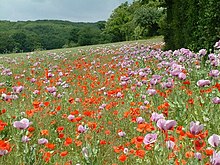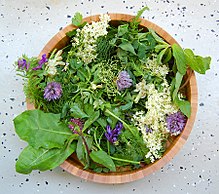Weeds
The term wild herbs refers to herbaceous wild plants (as opposed to cultivated plants influenced by breeding ), especially in the immediate vicinity of humans, in gardens , arable land and fringing biotopes . The term is used to emphasize the usefulness of the plant and, similar to the neutral term " weeds ", is occasionally used as a synonym for the term weed in order to avoid its very negative connotation.
Terminology
Use of the term weeds
- as a substitute for the term “weeds”, and in this sense synonymous with the terms
- Weeds , if we are talking about plants that grow in competition with cultivated plants, and
- Field weeds , especially in the context of nature conservation , with the same restriction as for "weeds",
- for wild herbs that serve as food plants for humans, and thus as a generic term for
- Wild vegetables or, in contrast to this, herbs that are only used in small quantities in the kitchen
- Herbs that are used in small quantities, as they have a flavorful character.
- Medicinal herbs with special medicinal functions ascribed to them.
Fruits and berries or mushrooms collected in the wild are not referred to as wild herbs.
Wild herbs in the diet
The term wild herbs in the kitchen and in recipe collections summarizes the plants that are suitable for consumption and are not cultivated, but are native to the respective country, i.e. thrive in meadows and fields or in floodplains and forests . Even if such plants are promoted or cultivated by horticulture, it is still common to speak of wild herbs as long as they have not been changed through breeding. For example, the flowers of the daisy or the leaves of the common dandelion can be used for salads , wild garlic is suitable as a seasoning addition, nettles can be processed like spinach .
The use of wild herbs has been common since prehistoric times, but mostly poorly documented historically, as it is rarely mentioned in documents. The traditional use took place within the framework of subsistence farming , mostly by the poor, rural rural population. In more recent times it has been common especially in times of war and emergency and was propagated by the state in both world wars in Germany as part of the self-sufficiency efforts. Since the 1980s, the use of wild herbs has experienced a renaissance in the context of the environmental movement, now mainly by richer, well-educated townspeople. The background is the longing for a simple, nature-determined life. In addition to vegetarians , the focus is on supporters of the “ Slow Food ” movement. Since the knowledge and use of herbs is more culturally connoted than feminine, women outweigh men. Knowledge of wild herbs is naturally particularly valued in the context of the so-called Stone Age cuisine or among survival fans. Numerous seminars and training courses impart not only recipes but also the necessary knowledge of species. Although wild herbs have a healthy image, improper use can be harmful to health. The food activist Udo Pollmer warns of “green smoothies ” made from wild herbs.
Although wild herbs are traded on weekly markets, the supply in the trade is usually limited. Standardization and quality control pose problems here. Cultivation takes place at best as a niche product to a small extent. A smaller German provider that had meanwhile established itself on the market has since given up this business area.
The wild herbs usually taste more intense than the cultivated varieties. There are also some flavor variants for which there is currently no equivalent in cultivated plants , such as sorrel , as this has not yet been cultivated (the cultivated plant sold as "sorrel" is the garden dock ). You can sow a suitable meadow with your preferred wild vegetables in the garden without much effort. The maintenance effort is limited to the harvest and a mowing in late summer. However, only those wild herbs will thrive if their location requirements are sufficiently satisfied by the individual location conditions there such as soil properties, heat, humidity, light conditions, etc.
In addition to wild herbs, which can enrich the menu, there are also numerous medicinal herbs whose effectiveness has been proven. These include chamomile , St. John's wort and yarrow , which can be found on poor meadows or can also be grown in the garden.
Wild herbs as weeds

Traditionally fought bitterly by farmers as competitors for crops, wild herbs that have become rare today have become objects of protection for nature conservation. To promote them, special field flora reserves are set up, so-called colored fallow areas and flower strips , which are included in the cultivation of fields, and they should especially encourage them. In addition to the general goal of maintaining the biodiversity of the agricultural landscape, beneficial organisms such as wild bees should also be promoted.
Instead of weeds, the term wild herbs has established itself for spontaneous vegetation on paved areas, for example in wall joints and pavement cracks. In the agricultural sector, some more ecologically minded authors also prefer the term weeds. In gardens, both expressions are common, depending on the context, the expression weeds is now also accepted by institutions such as the Agricultural Industry Association and the Residential Property Association .
literature
- Birgit Auerswald: Nutritious spontaneous vegetation. In: Land and Lie; Notebook of the Kassel School. Volume 42, Kassel 1996.
- Birgit Klose, A. Wegmann-Klose: Nutritious landscapes. Diploma thesis at the Department of Architecture, Urban Planning, Landscape Planning at the University of Kassel ; archived manuscript; Information system planning; Kassel 1990.
- Michael Machatschek: Nutritious landscape. Böhlau, Vienna 1999, ISBN 3-205-99005-6 (part 1), ISBN 3-205-77198-2 (part 2).
- Ralf Hiener, Olaf Schnelle, Anne Freidanck: Wild herbs. Edible landscapes. Nature & kitchen. Hädecke, edition: 2nd, edition. (July 2005), ISBN 3-7750-0452-1 .
- Brigitte Klemme, Dirk Holtermann: Un-herbs to enjoy. Rau, Düsseldorf 2002, ISBN 3-925691-25-1 .
- Jean-Marie Dumaine: My wild plant kitchen, 100 recipes for gourmets. AT Verlag, 2005, ISBN 3-85502-823-0 .
- Steffen Guido Fleischhauer: Encyclopedia of the edible wild plants. AT Verlag, 2005, ISBN 3-85502-889-3 .
- Steffen Guido Fleischhauer: Wild Pflanzen-Salate AT Verlag, 2006, ISBN 3-03800-260-7 .
- Eva-Maria and Wolfgang Dreyer: Recognize wild herbs, berries and mushrooms, collect and enjoy. Kosmos Verlag, Stuttgart, ISBN 3-440-10148-7 .
- Gertrud Scherf: Wild herbs & wild fruits. Blv Verlagsgesellschaft, 2011, ISBN 978-3-8354-0718-3 .
Web links
Individual evidence
- ↑ Note: No corresponding euphemism has been established for the analogous term " pest " : Bernd Herrmann: To the historicization of pest control. In Bernd Herrmann (editor): "... my field is time", essays on environmental history. Universitätsverlag Göttingen, 2011, ISBN 978-3-941875-99-9 . The term " beneficial " is less widespread and should be seen more as an antithesis than as a neutral synonym for "pests".
- ↑ Wild vegetables. Definition - well-known representative website of the ÖGE Austrian Society for Nutrition, accessed on April 18, 2016.
- ↑ an overview in: Ingeborg Nitschke: Collecting and using wild plants. Everyday food - emergency food - luxury food, from a folklore and cultural science perspective. Dissertation, Vienna, 2008.
- ↑ Achim Werner, Jens Dummer: Stone Age - Meal. From the first farmers to Ötzi. With 55 new recipes from the 5-stone chef. Theiss Verlag, Stuttgart 2013, ISBN 978-3-8062-2580-8 .
- ↑ cf. Wild herbs in the city: food from the grass verge by Bettina Levecke. Spiegel online, from September 25, 2015.
- ↑ Dangerous kitchen trend: Green smoothies - kidney stones included on Deutschlandradio Kultur , article from May 10, 2014.
- ↑ Conradin Bollinger: Weeds for Eating - Trend or Madness? In: Bio aktuell (magazine of the platform for Swiss organic farmers) Issue 3/2005: pp. 12–15.
- ↑ Stefan Meyer, Werner Hilbig, Kristina Steffen, Sebastian Schuch: Ackerwildkrautschutz - Eine Bibliographie. BfN-Skripten 351, 2013. published by the BfN Federal Agency for Nature Conservation, Bonn-Bad Godesberg.
- ↑ Thomas van Elsen & Dorothee Braband: Wild herb protection - an honorable ecological achievement? Perspectives against the background of the failure of classic protection concepts. In Ulrich Hampicke and the Greifswald Landscape Economics working group (project management): Incentive Economics of rewarding ecological services. BfN-Skripten 179, 2006. published by the BfN Federal Agency for Nature Conservation, Bonn-Bad Godesberg
- ^ Yvonne Reisner, Lukas Pfiffner, Bernhard Freyer: Buntbrachen. In: Bruno Baur, Andreas Erhardt , Klaus C. Ewald, Bernhard Freyer (eds.): Ecological balance and biodiversity. Springer-Verlag 1997, ISBN 3-7643-5802-5 .
- ↑ Christian Schmid-Egger, Rolf Witt: Field flower strips for wild bees - What do they really bring? In: Ampulex 6/2014: pp. 13-22.
- ^ Rolf König: Weed removal. In: BULA specialist magazine for procurement management in the public sector, August 2011: pp. 40–41.
- ↑ Weeds on paths and squares. Water and plant protection on public and commercial areas. Conference of the Julius Kühn Institute, September 2011 in Braunschweig. Conference proceedings, compiled by Arnd Verschwele.
- ↑ A. Kästner, Eckehart J. Jäger, R. Schubert: Handbook of the Segetal Plants of Central Europe. Springer-Verlag, 2013.
- ^ Joachim Hüppe: The arable weed societies in the Westphalian Bight (= treatises from the Westphalian Museum of Natural History. 49 (1)).
- ↑ cf. Not all weeds are the same on gartenfreunde.de from July 27, 2015.
- ↑ Weeds or "weeds"? in profile online, IVA magazine, issue of May 12, 2011.
- ↑ weeds or weeds? ( Memento of the original from November 12, 2016 in the Internet Archive ) Info: The archive link was inserted automatically and has not yet been checked. Please check the original and archive link according to the instructions and then remove this notice. on gartenberatung.de, published by the Verband Wohneigentum eV, accessed on April 18, 2016.
